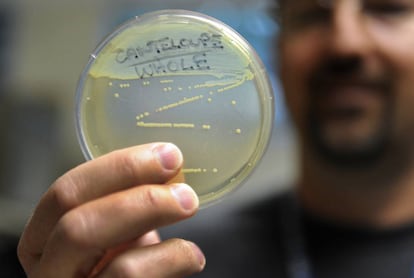Listeria, the stealthy pathogen that kills 70 people a year in Spain
The country ranks third in the EU for reported cases of listeriosis, which is caused by a common bacteria that withstands freezing temperatures and oxygen starvation

Five patients at hospitals in Manchester and Liverpool have died in the last 15 days from ingesting contaminated chicken sandwiches, and the European Center for Disease Prevention and Control has spent a year tracking an outbreak of listeriosis linked to smoked salmon that has already caused five deaths in northern Europe.
According to industry researchers at the first Barcelona Food Safety Forum last Friday, listeriosis is the most urgent challenge on the agenda.
Other bacteria spoil the product and the consumer can see the risk, but listeria gives no indication that it is there
José Juan Rodríguez, Spanish Society for Food Safety
Little known to the public at large because it causes a steady trickle of cases rather than full-blown outbreaks, Listeria monocytogenes has become the biggest risk in Europe’s kitchens in the last 10 years; an almost innocuous microorganism as far as most healthy people are concerned, it can be lethal to unborn children and people with suppressed immune systems. In Spain, the average number of deaths due to listeria has risen to 70 a year since 2009.
“It is a bacteria that can withstand adverse conditions such as the absence of oxygen and freezing temperatures,” says Raquel Abad from the National Microbiology Center. “And it doesn’t give any warning,” adds José Juan Rodríguez, a professor at Barcelona’s Autonomous University and a member of the Spanish Society for Food Safety. “Other bacteria spoil the product and the consumer can see the risk, but listeria gives no indication that it is there.”
Extremely common in nature, it is often found in cultivated soil as well as in livestock feed and also in several species of wild and domestic animals. It can enter the food chain from any of these departure points and reach our kitchens via raw products, such as fruit, vegetables and unpasteurized milk, or via processed food using infected raw materials. The most common cases are raw meat, vacuum-packed sliced cold cuts, soft cheeses made with unpasteurized milk and smoked products. The bacteria thrive in the fruit and vegetable drawer of the fridge where they multiply despite the cold temperatures.
More reports
The epidemiologist Zaida Herrador from the Carlos III Health Institute is the main author of the biggest research effort to date on the incidence of listeria in Spain. From 1997 to 2015, a total of 5,696 people were admitted to hospital for listeriosis. Almost 1,000 of these cases proved lethal (17%) in a trend that has seen the average figure of 20 annual deaths two decades ago rise to an average of 70 in recent years. “It’s a growing problem, and there is still a lot to be investigated,” says Herrador. “We can see that the number of cases is growing noticeably, but presumably this is because they are being reported more. It wasn’t an illness that had to be declared until 2015.”
Advice for pregnant women and the immunosuppressed
· Hands. Wash with soap and hot water for at least 20 seconds before and after touching food.
· The kitchen. Surfaces, boards and utensils should be washed carefully after being used on meat, fish, fruit, vegetables and any other raw food.
· The fridge. Make sure that the fridge is kept at 4ºC or under. Keep cooked food in the fridge for minimal periods, in closed containers and away from cheeses and raw food. Always respect the sell-by date on pre-cooked foods.
· Cooking. Cook meat thoroughly until it reaches 71ºC – the point at which it changes color in the middle. The leftovers should not be eaten cold, and should be reheated to above 75ºC.
· Dairy. Unpasteurized milk should be avoided as well as cheeses made with it, particularly soft cheeses.
· Meat and cold cuts. Do not eat raw or under-done meat, nor vacuum-packed sliced cold cuts, apart from those which have been cooked at 71ºC which might be found in croquettes or on pizzas.
· Fish. It is unadvisable to eat refrigerated smoked or marinated fish products, or refrigerated patés.
· Vegetables. Do not eat raw sprouts such as soya and alfalfa, or fruit and vegetables without either peeling or disinfecting them. This includes bags of salad greens.
· Sandwiches. Avoid pre-packed sandwiches that contain vegetables, egg, meat, cold meat and fish.
According to this study, published last week by Eurosurveillance, 50% of those affected are over 65 and the main associated risk factors are cancer, diabetes, chronic liver disease and transplants. “It’s a trend that goes hand in hand with a longer life expectancy,” says Herrador. “We live longer and we are able to do so with more chronic illnesses. But that means that there is an increased percentage of people living with a weakened immune system who are therefore more vulnerable.”
Listeriosis scarcely affects healthy members of the population. Ten percent of people are asymptomatic carriers and infected products cause little more than a bout of gastroenteritis and non-specific fever. But the research points out that among the at-risk hospitalized population, 43% develop a condition known as meningoencephalitis. In these cases, fatalities can rise above 50%, with chronic neurological consequences for more than half of those who survive. The time spent in hospital for listeriosis usually averages 21.4 days and costs more than €6,300 per patient.
Herrador and Abad both believe that listeriosis cases are frequently not reported. In Spain, for example, there are huge differences in registered incidents between the autonomous regions. Catalonia and the Basque Country are at the top with 20 hospital admissions for every 100,000 inhabitants while Murcia and Valencia are at the other end of the spectrum with less than eight.
“It could be due to eating habits, but it is more likely that the regions with more reported cases are the regions that are more on top of it. The Basque Country has registered several outbreaks which have shone the spotlight on the issue,” says Herrador.
On a European scale, Spain had the third highest incidence of reported listeriosis cases in 2016, trailing Germany and France, according to the European Center for Disease Prevention and Control.
Listeria usually enters the food chain from farms. “It is fundamental to pay close attention to hygiene measures,” says Rodríguez. “You have to see if it is in the factory and to what degree, which is done by analyzing samples of the end-product.”
Listeria develops biofilms, which are communities of microorganisms that grow on almost any surface and are very difficult to detect. “The strictest measures need to be applied to detect and eliminate them,” says Rodríguez. “But we still need to advance technologically and develop new hygiene products, and it is inevitable that a small proportion of food products that go on the market will carry the bacteria.”
The risks of infection to the unborn child
Listeria can cause problems during pregnancy. “It is a difficult infection to diagnose during pregnancy but it can have fatal consequences,” says Antonio García Burguillo, head of Obstetrics and Gynecology at the 12 de Octubre Hospital in Madrid. “Many women are infected but show no symptoms or only slight ones, but then have miscarriages or pass the bacteria on to the unborn child. “
According to the Carlos III Health Institute’s research, 7% of the 5,696 hospital admissions for listeriosis between 1997 and 2015 were pregnant women and 4% were newborns. But even among pregnant women and newborns, not all cases are registered as such.
“Of the cultures from samples taken from the mother of newborns with listeriosis, where we know that the mother was the source of the infection, 45% showed up negative,” says García Burguillo, explaining the difficulties involved in diagnosing the infection. “We know that there are three main risks to the fetus from listeriosis: miscarriage; newborn septicemia with a high fatality rate, and finally meningitis that can seriously affect the child’s development.”
English version by Heather Galloway.
Tu suscripción se está usando en otro dispositivo
¿Quieres añadir otro usuario a tu suscripción?
Si continúas leyendo en este dispositivo, no se podrá leer en el otro.
FlechaTu suscripción se está usando en otro dispositivo y solo puedes acceder a EL PAÍS desde un dispositivo a la vez.
Si quieres compartir tu cuenta, cambia tu suscripción a la modalidad Premium, así podrás añadir otro usuario. Cada uno accederá con su propia cuenta de email, lo que os permitirá personalizar vuestra experiencia en EL PAÍS.
¿Tienes una suscripción de empresa? Accede aquí para contratar más cuentas.
En el caso de no saber quién está usando tu cuenta, te recomendamos cambiar tu contraseña aquí.
Si decides continuar compartiendo tu cuenta, este mensaje se mostrará en tu dispositivo y en el de la otra persona que está usando tu cuenta de forma indefinida, afectando a tu experiencia de lectura. Puedes consultar aquí los términos y condiciones de la suscripción digital.
More information
Archived In
Últimas noticias
Most viewed
- Sinaloa Cartel war is taking its toll on Los Chapitos
- Oona Chaplin: ‘I told James Cameron that I was living in a treehouse and starting a permaculture project with a friend’
- Reinhard Genzel, Nobel laureate in physics: ‘One-minute videos will never give you the truth’
- Why the price of coffee has skyrocketed: from Brazilian plantations to specialty coffee houses
- Silver prices are going crazy: This is what’s fueling the rally











































